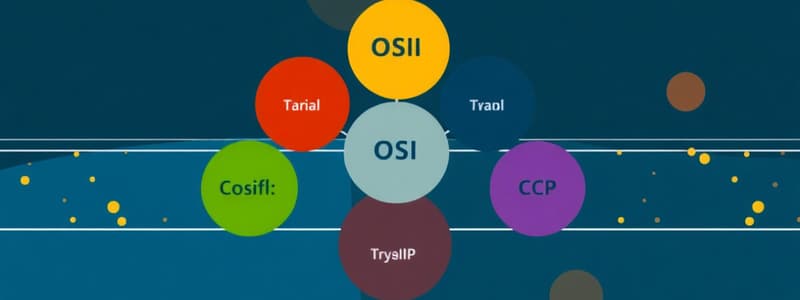Podcast
Questions and Answers
What is the primary function of the Session layer in the OSI model?
What is the primary function of the Session layer in the OSI model?
- To manage dialogue and data exchange for the Presentation layer. (correct)
- To provide mechanical properties for data transmission.
- To segment and transfer data across the network.
- To facilitate process-to-process communication.
Which layer of the OSI model is responsible for exchanging data frames between devices?
Which layer of the OSI model is responsible for exchanging data frames between devices?
- Transport Layer
- Network Layer
- Physical Layer
- Data Link Layer (correct)
Which statement accurately reflects a difference between the OSI model and the TCP/IP model?
Which statement accurately reflects a difference between the OSI model and the TCP/IP model?
- The OSI model was created in the early 1980s while TCP/IP was developed in the late 1960s.
- The TCP/IP model includes a session layer, whereas the OSI model does not.
- The TCP/IP model combines functions of the network access and application layers into a single layer. (correct)
- The OSI model has an application layer, while the TCP/IP does not.
What role does the Transport layer play within the OSI model?
What role does the Transport layer play within the OSI model?
Which of the following describes the function of the Physical layer in the OSI model?
Which of the following describes the function of the Physical layer in the OSI model?
Which type of media is specifically designed to reduce the effects of crosstalk?
Which type of media is specifically designed to reduce the effects of crosstalk?
What is a common disadvantage of Shielded Twisted-Pair Cable (STP) compared to Unshielded Twisted-Pair Cable (UTP)?
What is a common disadvantage of Shielded Twisted-Pair Cable (STP) compared to Unshielded Twisted-Pair Cable (UTP)?
Which form of interference can distort data signals in copper media?
Which form of interference can distort data signals in copper media?
What is one key characteristic of the signaling in copper media?
What is one key characteristic of the signaling in copper media?
Which of the following characteristics is true regarding overall signal quality on copper wires?
Which of the following characteristics is true regarding overall signal quality on copper wires?
What type of connector is commonly used with UTP cabling?
What type of connector is commonly used with UTP cabling?
Which of the following is NOT a type of copper media mentioned?
Which of the following is NOT a type of copper media mentioned?
What problem does crosstalk primarily result from?
What problem does crosstalk primarily result from?
What does throughput measure in the context of network communication?
What does throughput measure in the context of network communication?
What term is used to describe the process of dividing large streams of data into smaller pieces?
What term is used to describe the process of dividing large streams of data into smaller pieces?
In the context of the physical layer, what does a long pulse represent?
In the context of the physical layer, what does a long pulse represent?
Which layer's Protocol Data Unit (PDU) is referred to as a 'Frame'?
Which layer's Protocol Data Unit (PDU) is referred to as a 'Frame'?
Goodput is defined as which of the following?
Goodput is defined as which of the following?
What is the primary purpose of multiplexing in network communication?
What is the primary purpose of multiplexing in network communication?
What does the de-encapsulation process do?
What does the de-encapsulation process do?
Which of the following is NOT a factor that affects throughput?
Which of the following is NOT a factor that affects throughput?
What is the primary purpose of network layer addresses in an IP packet?
What is the primary purpose of network layer addresses in an IP packet?
What triggers the de-encapsulation process in a receiving device?
What triggers the de-encapsulation process in a receiving device?
What differentiates the network portion of an IP address from the host portion?
What differentiates the network portion of an IP address from the host portion?
What is the role of a default gateway when communicating with a remote network?
What is the role of a default gateway when communicating with a remote network?
Which address provides the specific device ID on a network for data link communication?
Which address provides the specific device ID on a network for data link communication?
In the context of encapsulation, what does an Ethernet frame contain?
In the context of encapsulation, what does an Ethernet frame contain?
Which statement best describes the role of network protocols?
Which statement best describes the role of network protocols?
What information is NOT found in a data link address?
What information is NOT found in a data link address?
What are the three main elements common to all communication methods?
What are the three main elements common to all communication methods?
What must happen to messages before transmission across a network?
What must happen to messages before transmission across a network?
What is the role of flow control in network communications?
What is the role of flow control in network communications?
Which component acts like an envelope providing source and destination addresses for a message?
Which component acts like an envelope providing source and destination addresses for a message?
What should hosts on a network do in the event of a response timeout?
What should hosts on a network do in the event of a response timeout?
Which of the following options is NOT a component of protocols for effective communication?
Which of the following options is NOT a component of protocols for effective communication?
How do humans typically format long messages for effective communication?
How do humans typically format long messages for effective communication?
Which of the following is a message delivery option mentioned in network communications?
Which of the following is a message delivery option mentioned in network communications?
Study Notes
Telecommunication Standards and Protocol Models
- The International Telecommunications Union (ITU) focuses on video compression, IPTV, and broadband communication standards.
- OSI Reference Model is divided into seven layers: Application, Presentation, Session, Transport, Network, Data Link, and Physical.
- TCP/IP Protocol Model, developed in the early 1970s, is streamlined with only four layers: Application, Transport, Internet, and Network Access.
OSI Model Layers
- Application Layer: Manages process-to-process communication.
- Presentation Layer: Ensures data is represented in a common format.
- Session Layer: Handles dialogue management and data exchange.
- Transport Layer: Segments data for transfer and reassembly.
- Network Layer: Routes individual data pieces across the network.
- Data Link Layer: Manages exchanges of data frames over the physical medium.
- Physical Layer: Covers the mechanical and electrical means of transmitting bits.
TCP/IP Model Comparison
- TCP/IP merges the OSI’s Application layer and Network Access layer, simplifying the model.
- The model is open standard and facilitates internetwork communications.
Physical Media
- Types of physical media include copper wires, optical fibers, and wireless signals such as radio and microwaves.
- Copper media characteristics include attenuation, limited distance, susceptibility to interference (EMI/RFI), and crosstalk.
Types of Copper Cables
- Unshielded Twisted-Pair (UTP) Cable: Most common, uses RJ-45 connectors, susceptible to EMI.
- Shielded Twisted-Pair (STP) Cable: Offers better protection against interference; more expensive and difficult to install.
- Coaxial Cable: Utilizes a copper conductor for signal transmission.
Throughput and Goodput
- Throughput: Measures bit transfer rate; typically less than specified due to network factors.
- Goodput: Accounts for the effective data transfer rate, excluding overhead from protocol operations.
Data Handling in Networking
- Message Segmentation: Large data streams are broken down into smaller segments for transmission.
- Encapsulation Process: Data layers encapsulate as they move down the protocol stack, changing into respective Protocol Data Units (PDUs): Data (Application), Segment (Transport), Packet (Network), Frame (Data Link), and Bits (Physical).
- De-encapsulation: The reverse process during data reception to extract the original data from headers.
Addressing in Networks
- Data Link Addresses (MAC): Facilitate delivery of frames between devices on the same network.
- Network Addresses (IP): Indicate the original source and final destination of packets, comprising network and host portions.
Communication Protocols
- Essential for effective communication, protocols ensure identified senders and receivers, common formatting, and acknowledgment processes.
- Include rules for message encoding, delivery options, timing, and message size.
Flow Control and Access Methods
- Hosts must manage message timing and respond correctly during collisions.
- Flow control techniques prevent overwhelming the receiving host and negotiate data transfer rates.
Summary of Communication Components
- Essential elements of any communication: sender, receiver, media, and protocols governing interaction.
- Common requirements include message timing, size, formatting, and delivery acknowledgment.
Studying That Suits You
Use AI to generate personalized quizzes and flashcards to suit your learning preferences.
Related Documents
Description
This quiz covers key concepts related to telecommunication standards and protocol models, including the OSI and TCP/IP models. Explore the functional layers of the OSI model, from application to physical, and understand their roles in communication. Test your knowledge of video compression, IPTV, and broadband standards as established by the ITU.




